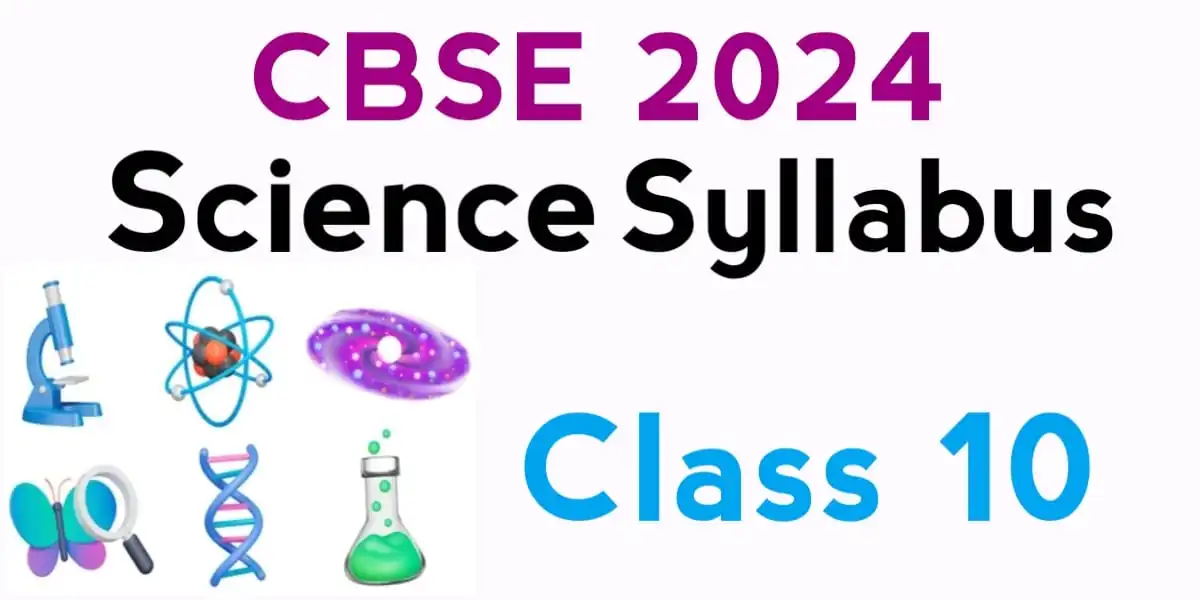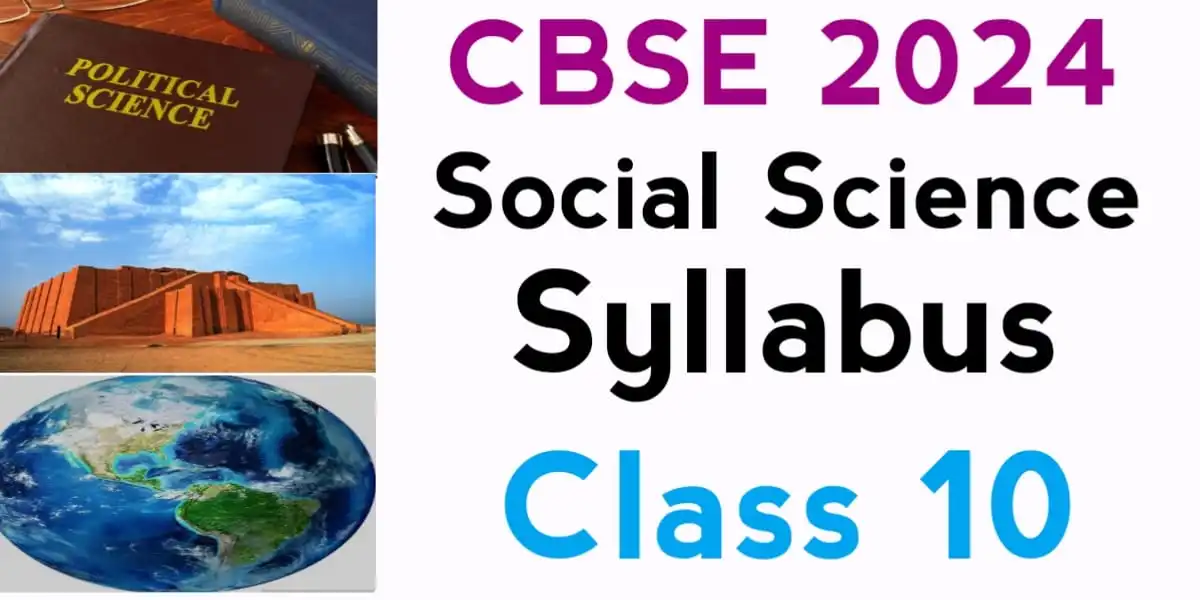CBSE Class 10 Science syllabus for 2023-24 has been released, and the complete syllabus can be downloaded from the provided link.
The Central Board of Secondary Education (CBSE) has published the updated CBSE Science Syllabus for Class 10 (2023-24), designed for practical learning and real-world applications.
So, stay updated with the CBSE Science Syllabus for Class 10 and gear up for the academic year 2023-24.
The syllabus is designed to keep pace with the changing educational landscape, ensuring students receive the best possible education.
Let’s delve into the key aspects of the CBSE Science Syllabus for Class 10 2023-24 that students and educators need to be aware of.
General Instruction for CBSE Class 10 Science Syllabus 2023-24
1. There will be an Annual Examination based on the entire syllabus.
2. The Annual Examination will be of 80 marks and 20 marks weightage shall be forInternal Assessment.
3. For Internal Assessment:
a. There will be Periodic Assessment that would include:
- For 5 marks- Three periodic tests conducted by the school. Average of the best two tests to be taken that will have a weightage of 05 marks towards the final result.
- For 5 marks- Diverse methods of assessment as per the need of theclass dynamics and curriculum transaction. These may include – short tests, oral test, quiz, concept maps, projects, posters, presentations and enquiry based scientific investigations etc. and use rubrics for arguing them objectively. This will also have a weightage of 05 marks towards the final result.
b. Practical / Laboratory work should be done throughout the year and the student should maintain record of the same. Practical Assessment should be continuous. There will be weightage of 5 marks towards the final result. All practicals listed in the syllabus must be completed.
c. Portfolio to be prepared by the student- This would include classwork and other sample of student work and will carry a weightage of 5 marks towards the final results
Download CBSE Science Syllabus for Class 10 2033-24
Related Topic
Course Structure for Class 10 CBSE Science Syllabus 2023-24
COURSE STRUCTURE
SCIENCE
(Code No. 086)
CLASS X
(Annual Examination)
Marks: 80
| Unit No. | Unit | Marks |
| I | Chemical Substances-Nature and Behaviour | 25 |
| II | World of Living | 25 |
| III | Natural Phenomena | 12 |
| IV | Effects of Current | 13 |
| V | Natural Resources | 05 |
| Total | 80 | |
| Internal assessment | 20 | |
| Grand Total | 100 |
Unit-wise CBSE Science Syllabus For Class 10 2023-24
Theme: Materials
Unit I: Chemical Substances – Nature and Behaviour
Chemical reactions: Chemical equation, Balanced chemical equation, implications of a balanced chemical equation, types of chemical reactions: combination, decomposition, displacement, double displacement, precipitation, endothermic exothermic reactions, oxidation and reduction.
Acids, bases and salts: Their definitions in terms of furnishing of H+ and OH– ions, General properties, examples and uses, neutralization, concept of pH scale (Definition relating to logarithm not required), importance of pH in everyday life; preparation and uses of Sodium Hydroxide,Bleaching powder, Baking soda, Washing soda and Plaster of Paris.
Metals and nonmetals: Properties of metals and non-metals; Reactivity series; Formation and properties of ionic compounds; Basic metallurgical processes; Corrosion and its prevention.
Carbon compounds: Covalent bonding in carbon compounds. Versatile nature of carbon. Homologous series. Nomenclature of carbon compounds containing functional groups (halogens, alcohol, ketones, aldehydes, alkanes and alkynes), difference between saturated hydro carbons and unsaturated hydrocarbons. Chemical properties of carbon compounds (combustion, oxidation, addition and substitution reaction). Ethanol and Ethanoic acid (only properties and uses), soaps and detergents.
Theme: The World of the Living
Unit II: World of Living
Life processes: ‘Living Being’. Basic concept of nutrition, respiration, transport and excretion in plants and animals.
Control and co-ordination in animals and plants: Tropic movements in plants; Introduction of plant hormones; Control and co-ordination in animals: Nervous system; Voluntary, involuntary and reflex action; Chemical co-ordination: animal hormones.
Reproduction: Reproduction in animals and plants (asexual and sexual) reproductive health – need and methods of family planning. Safe sex vs HIV/AIDS. Child bearing and women’s health.
Heredity and Evolution: Heredity; Mendel’s contribution- Laws for inheritance of traits: Sex determination: brief introduction: (topics excluded – evolution; evolution and classification and evolution should not be equated with progress).
Theme: Natural Phenomena
Unit III: Natural Phenomena
Reflection of light by curved surfaces; Images formed by spherical mirrors, centre of curvature, principal axis, principal focus, focal length, mirror formula (Derivation not required),magnification. Refraction; Laws of refraction, refractive index.
Refraction of light by spherical lens; Image formed by spherical lenses; Lens formula(Derivation not required); Magnification. Power of a lens.
Functioning of a lens in human eye, defects of vision and their corrections, applications of spherical mirrors and lenses.
Refraction of light through a prism, dispersion of light, scattering of light, applications in dailylife (excluding colour of the sun at sunrise and sunset).
Theme: How Things Work
Unit IV: Effects of Current
Electric current, potential difference and electric current. Ohm’s law; Resistance, Resistivity, Factors on which the resistance of a conductor depends. Series combination of resistors, parallel combination of resistors and its applications in daily life. Heating effect of electric current and its applications in daily life. Electric power, Interrelation between P, V, I and R. Magnetic effects of current : Magnetic field, field lines, field due to a current carryingconductor, field due to current carrying coil or solenoid; Force on current carrying conductor, Fleming’s Left Hand Rule, Direct current. Alternating current: frequency of AC. Advantage of AC over DC. Domestic electric circuits.
Theme: Natural Resources
Unit V: Natural Resources
Our environment: Eco-system, Environmental problems, Ozone depletion, waste production and their solutions. Biodegradable and non-biodegradable substances.
Practicals for CBSE Class 10 Science Syllabus
Practicals should be conducted alongside the concepts taught in theory classes.
LIST OF EXPERIMENTS
Unit-I
1. A. Finding the pH of the following samples by using pH paper/universal indicator:
(i) Dilute Hydrochloric Acid
(ii) Dilute NaOH solution
(iii) Dilute Ethanoic Acid solution
(iv) Lemon juice
(v) Water
(vi) Dilute Hydrogen Carbonate solution
Unit-I
B. Studying the properties of acids and bases (HCl & NaOH) on the basis of their reaction with:
a) Litmus solution (Blue/Red)
b) Zinc metal
c) Solid sodium carbonate
Unit-I
2. Performing and observing the following reactions and classifying them into:
A. Combination reaction
B. Decomposition reaction
C. Displacement reaction
D. Double displacement reaction
(i) Action of water on quicklime
(ii) Action of heat on ferrous sulphate crystals
(iii) Iron nails kept in copper sulphate solution
(iv) Reaction between sodium sulphate and barium chloride solutions
Unit-II
3. Observing the action of Zn, Fe, Cu and Al metals on the following salt solutions:
i) ZnSO4(aq)
ii) FeSO4(aq)
iii) CuSO4(aq)
iv) Al2 (SO4)3(aq)
Arranging Zn, Fe, Cu and Al (metals) in the decreasing order of reactivity based on the above result.
Unit-IV
4. Studying the dependence of potential difference (V) across a resistor on the current (I) passing through it and determining its resistance. Also plotting a graph between V and I.
Unit-IV
5. Determination of the equivalent resistance of two resistors when connected in series and parallel.
Unit- II
6. Preparing a temporary mount of a leaf peel to show stomata.
Unit-II
7. Experimentally show that carbon dioxide is given out during respiration.
Unit- I
8. Study of the following properties of acetic acid (ethanoic acid):
i) Odour
ii) solubility in water
iii) effect on litmus
iv) reaction with Sodium Hydrogen Carbonate
Unit- I
9. Study of the comparative cleaning capacity of a sample of soap in soft and hard water.
Unit-III
10. Determination of the focal length of:
i) Concave mirror
ii) Convex lens
by obtaining the image of a distant object.
Unit – III
11. Tracing the path of a ray of light passing through a rectangular glass slab for different angles of incidence. Measure the angle of incidence, angle of refraction, angle of emergence and interpret the result.
Unit-II
12. Studying (a) binary fission in Amoeba, and (b) budding in yeast and Hydra with the help of prepared slides.
Unit-III
13. Tracing the path of the rays of light through a glass prism.
Unit-II
14. Identification of the different parts of an embryo of a dicot seed (Pea, gram or red kidney bean).
Question Paper Design & Internal Assessment for Science 2023-24
Theory (80 marks)
Question Paper Design
(Class X)
Subject: Science
| Competencies | Total |
| Demonstrate Knowledge and Understanding | 46 % |
| Application of Knowledge/Concepts | 22 % |
| Formulate, Analyze, Evaluate and Create | 32 % |
| 100% |
Note:
Typology of Questions: VSA including objective type questions, Assertion – Reasoning type questions; SA; LA; Source-based/ Case-based/ Passage-based/ Integrated assessment questions.
An internal choice of approximately 33% would be provided.
Internal Assessment (20 Marks)
- Periodic Assessment – 05 marks + 05 marks
- Subject Enrichment (Practical Work) – 05 marks
- Portfolio – 05 marks
Suggestive verbs for various competencies
Demonstrate Knowledge and Understanding
State, name, list, identify, define, suggest, describe, outline, summarize, etc.
Application of Knowledge/Concepts
Calculate, illustrate, show, adapt, explain, distinguish, etc.
Formulate, Analyze, Evaluate and Create
Interpret, analyze, compare, contrast, examine, evaluate, discuss, construct, etc
Science Prescribed Books for Class 10
| SL NO | PRESCRIBED BOOKS: |
| 1. | Science-Textbook for class IX-NCERT Publication |
| 2. | Science-Text book for class X- NCERT Publication |
| 3. | Assessment of Practical Skills in Science-Class IX – CBSE Publication |
| 4. | Assessment of Practical Skills in Science- Class X- CBSE Publication |
| 5. | Laboratory Manual-Science-Class IX, NCERT Publication |
| 6. | Laboratory Manual-Science-Class X, NCERT Publication |
| 7. | Exemplar Problems Class IX – NCERT Publication |
| 8. | Exemplar Problems Class X – NCERT Publication |
The CBSE Science Syllabus for Class 10 in the academic year 2023-24 brings with it a wave of changes and opportunities. Adapting to these changes is not only necessary but also a stepping stone to a more enriched educational experience.
Related CBSE Class 10 Syllabus
FAQs
Is the new syllabus significantly different from the previous one?
While there are updates, the core structure remains similar. Students need to focus on the highlighted changes for effective preparation
Are there any specific resources recommended for self-study?
Yes, the article provides a list of recommended textbooks, online resources, and study materials to aid in self-study.
How can parents support their children through these syllabus changes?
Parental involvement, open communication, and creating a conducive study environment are key ways to support students.
Are there any interactive learning tools mentioned for better understanding?
Absolutely! The article explores various interactive learning tools and platforms to enhance the learning experience.
What is the significance of practical exams in the science syllabus?
Practical exams contribute to a holistic understanding of scientific concepts and their real-world applications.







